
| What is Flavor and Fortune? |
| How do I subscribe? |
| How do I get past issues? |
| How do I advertise? |
| How do I contact the editor? |
Read 12879275 times
Connect me to:
| Home |
| Articles |
| Book reviews |
| Letters to the Editor |
| Newmans News and Notes |
| Recipes |
| Restaurant reviews |
| Article Index (all years, slow) |
| List of Article Years |
| Article Index (2025) |
| Article Index (last 2 years) |
| Things others say |
| Related Links |
| Log In... |
| Authors |
| Categories & Topics |
Lotus: Loved, Luscious, and Honored
| by Jacqueline M. Newman |
Vegetables and Vegetarian Foods
Fall Volume: 2007 Issue: 14(3) page(s): 11, 12, 13, and 24
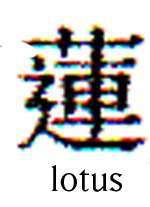
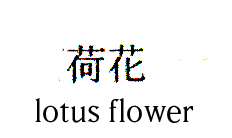

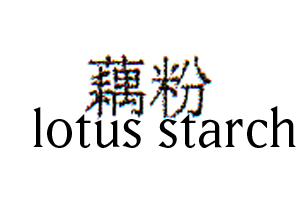 This perennial water plant, native to warm-weather areas in Asia, is planted for its ornamentality, its edibility, and its medicinality. As seen in the Letters to the Editor column in this issue, queries continue about this plant. They came before it was written about in Flavor and Fortune’s Volume 8 (4) on pages 11, 12, and 31, and they continue to come. Therefore, what follows is still more information. It is segmented into the most common parts eaten.
This perennial water plant, native to warm-weather areas in Asia, is planted for its ornamentality, its edibility, and its medicinality. As seen in the Letters to the Editor column in this issue, queries continue about this plant. They came before it was written about in Flavor and Fortune’s Volume 8 (4) on pages 11, 12, and 31, and they continue to come. Therefore, what follows is still more information. It is segmented into the most common parts eaten.
This is one way the Chinese look at the lotus. Another is by its aerial portions and those subterranean, These are called lian and ou, respectively. Every part of this plant above or below the water line is eaten by man, feeds his animals; and helps him medicinally.
A most satisfying way to enjoy the lotus is to admire its flowers. Another is to consume its lovely, even unusual swollen 'root' when raw. However, botanically speaking, that last statement is in error. It has no swollen root, that really is its rhizome. In any case, one can eat it after paring, slicing, and soaking it in cold water.
Another common error about this plant is to say that its seeds grow above ground. Truth be told, they can grow above or below the water line. So every part of this plant, no matter where it grows, can be appreciated for its taste and its beauty, and for its help when battling a weakness or treating an illness.
Experts in food history believe this plant was first domesticated in China. They know that it was used as part of crop rotation in early imperial fish ponds. Historians tell us the lotus was mentioned in the Shi-Qing, believed written about or during the Zhou Dynasty, circa 1,000 to 5,000 BCE.
There are others who say it was cultivated long before that; and they are correct. Why? Because lotus seeds have been found in jars in Neolithic tombs, specifically those near Chengdu. Some were also found in Han tombs, and in other early archeological sites.
In very early days, the Chinese ate lotus because they said it had tonic properties. In the Three Kingdoms period, circa 290 CE, rulers wanted their lotus seeds made sweet with honey. The lotus was so revered, that during the Ming Dynasty it was considered the fifth category of food under the supervision of the Emperor's Directorate of Foodstuffs. Earlier and then, chunks of fish were wrapped in lotus leaves as were meats, to preserve them. In later times, such as in the 1600's, lotus stems were spoken of 'as strong as a man's arm' and their seeds given so the recipient would 'have many sons.' In the Qing Dynasty, the royals adored theirs, leaves and all, made in Green Dumplings.
Often grown near Buddhist temples, lotus plants are found in ponds. Other religious folk appreciate the lotus, too. Monks can be seen keeping cool using lotus leaves as hats. The lotus flower is found in temples as part of a statue. Buddha is sitting on a lotus flower or a lotus seed pod. There are times, when looking at a statue of Buddha, one finds him holding a lotus flower. These flowers are said to calm mind and spirit; they are a symbol of purity, perfection, and beauty. To many Chinese, this plant, particularly its flower, has mystical meanings. To artists, poets, and writers, they serve as inspiration.
These are but a few uses of Nelumbo nucifera, as this plant is known botanically. Called lian in Chinese, this perennial buries its lower part in mud, and grows its thickened stem-like parts there. Its leaves sit on or above water and its flowers are there or they shoot upwards. Lotus seeds are in receptacles called lotus pods, and depending upon the stage of their development, they can be below or above the water line.
What follows next is, part by part, more information about the lotus; and following that, recipes for its many parts.
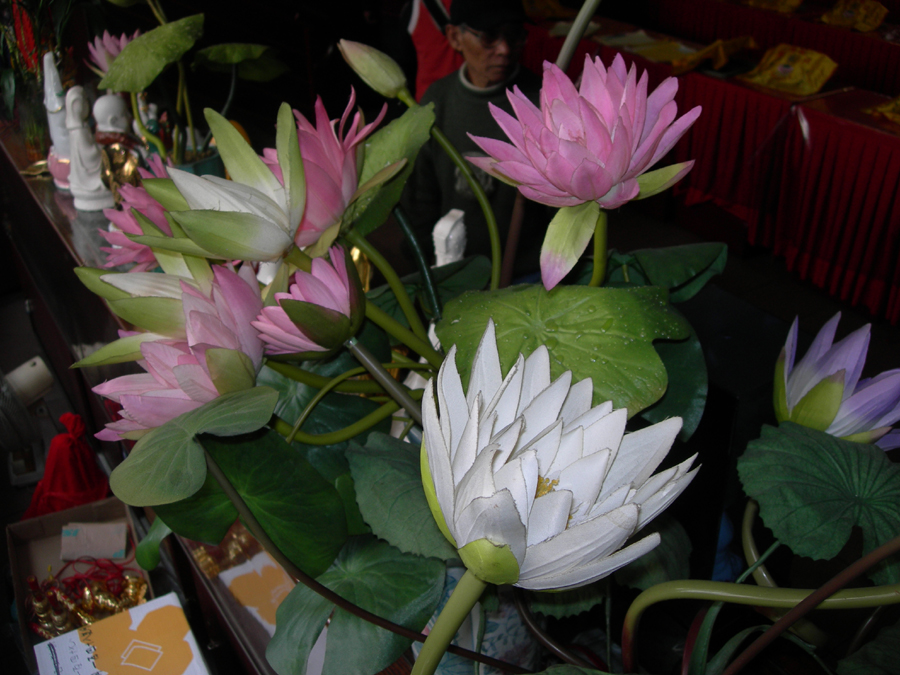 LOTUS FLOWERSare called he hua and are extensively cultivated for their beauty and for their symbolism. Emperors wanted to see them growing in their lakes, ponds, marshes, and other wet places. They also desired them in their kitchens, and prepared and placed on their tables. They enjoyed eating every part of the lotus, and no doubt their chefs had many recipes for them. One royal one, oft written about, says that the flower's petals are pulled off, washed, and cut diagonally, then blanched for a few seconds, immediately put in cold water, and then set aside ready for use in a favorite chicken dish. The leaves are also enjoyed and used when making lotus tea. Here, the petals are used to flavor the tea, as are jasmine, lychii, and other aromatic flower petals.
LOTUS FLOWERSare called he hua and are extensively cultivated for their beauty and for their symbolism. Emperors wanted to see them growing in their lakes, ponds, marshes, and other wet places. They also desired them in their kitchens, and prepared and placed on their tables. They enjoyed eating every part of the lotus, and no doubt their chefs had many recipes for them. One royal one, oft written about, says that the flower's petals are pulled off, washed, and cut diagonally, then blanched for a few seconds, immediately put in cold water, and then set aside ready for use in a favorite chicken dish. The leaves are also enjoyed and used when making lotus tea. Here, the petals are used to flavor the tea, as are jasmine, lychii, and other aromatic flower petals.
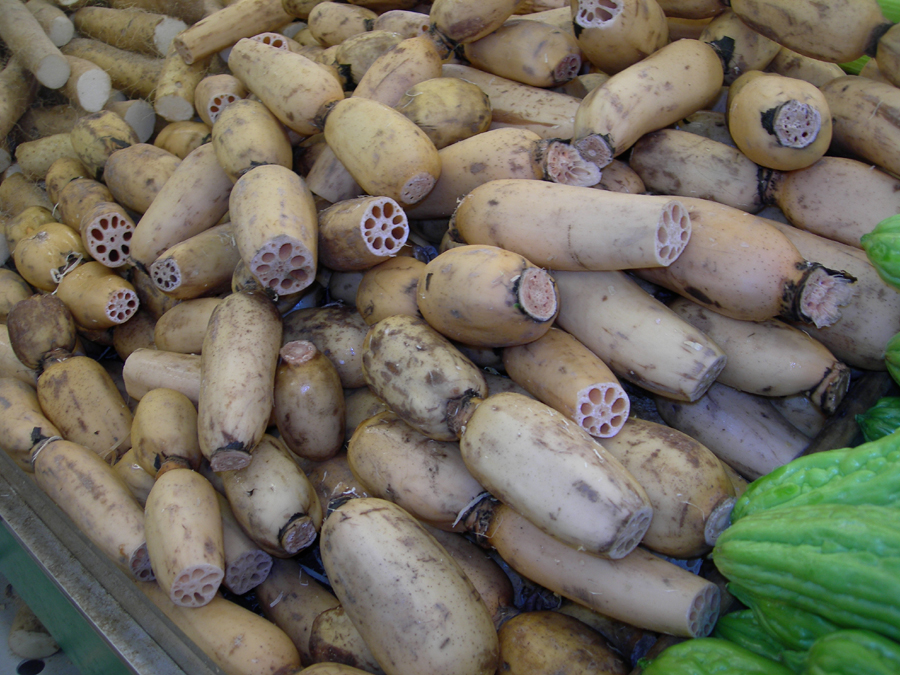 LOTUS STEMS are items incorrectly called lotus roots but correctly are called 'subaqueous rhizomes.' The Chinese refer to this part of the plant as ou and they say they can be eaten raw though they rarely are. Actually Southern Chinese like to use the stem fresh but not raw, while Northern Chinese prefer to use it after it is dried.
LOTUS STEMS are items incorrectly called lotus roots but correctly are called 'subaqueous rhizomes.' The Chinese refer to this part of the plant as ou and they say they can be eaten raw though they rarely are. Actually Southern Chinese like to use the stem fresh but not raw, while Northern Chinese prefer to use it after it is dried.
All Chinese use the stems cooked fresh, or dried, canned, frozen, or as a starch or flour. The stems can be pickled and put in what westerners might call a salad, they can be stir-fried, or used in long-cooked dishes. When boiled or fried, the stems become sweeter, when raw or pickled, they are more astringent. This horizontally growing part of the plant, the Chinese believe, calms fevers, cools blood, and clears blood poisonings. When boiled, they believe they invigorate both spleen and stomach.
To use this part of the plant that is fatter in their centers than their ends, each section is peeled first. When sliced, this exposes the holes that run each section's entire length. A common way to use them before slicing is to stuff the holes with glutinous rice alone or with other seasonings or finely chopped meat or foods of the sea. After that, one steams the sections and then slices them after cooking. Another common way is to peel, slice, and deep fry pieces of these sections without any stuffing. One can also make chips for use as a snack or for decor around a dish. After peeling, these lotus pieces can be used as a vegetable alone or in a soup or a stew-type dish.
LOTUS LEAVES are called he ye in Chinese, and this plant's leaves are sometimes called 'lotus greens.' They can be quite large, sometimes twelve to eighteen inches across, and they unfold in opposite directions when growing. Most commonly, lotus leaves are used to wrap foods. Then they are steamed until done, most often an hour to an hour and a half is needed. Food steamed in them can be served in/on the leaves or the leaves can be removed before serving the contents. After the leaves are removed, they are rinsed and hung like laundry, out on a line to dry. As was said earlier in this article, in early days, chunks of fish or those of meat were wrapped in lotus leaves to preserve them. We have yet to locate a recipe to do so. These days, and perhaps before, very young leaves are shredded and cooked as a green vegetable. A common use for them after cooking, is to put a stir-fry dish on them and then eat the greens with the dish.
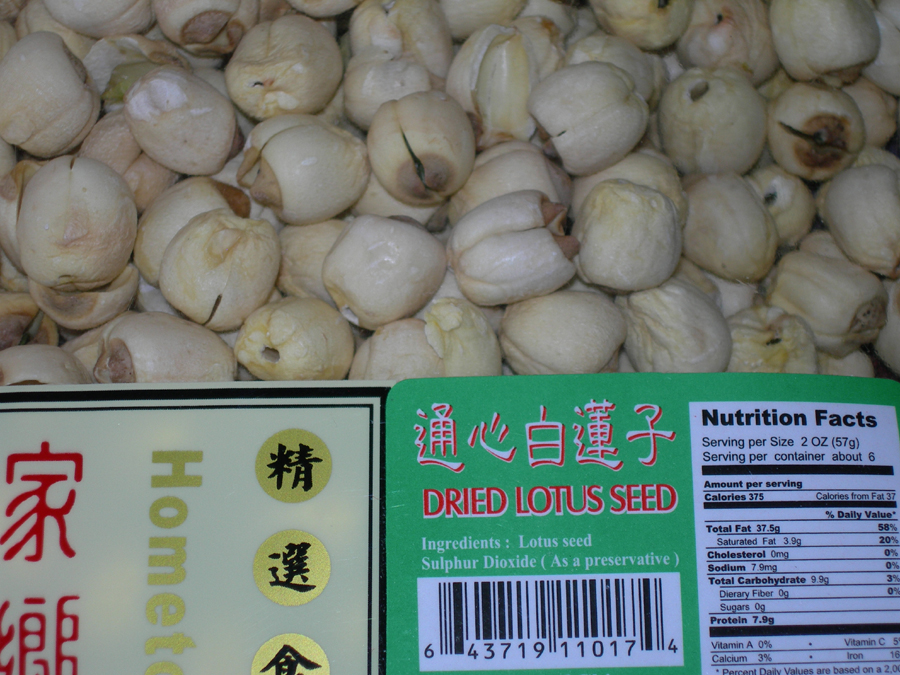 LOTUS SEEDS are the part of the lotus plant found in the stem; they can be found raw, dried, or canned; and they can be found ground into a flour. Called lian zi, lotus seeds have been referred to as 'lotus fruit.' Most often they are seen standing in a light brown pod above the water. At this stage they are ripe sitting in their seed pod. The pod itself, when less mature, is found in or under the water. It can be sliced and used in sir-fry dishes. Sometimes this part is called the 'lotus heart.' Medicinally, it is believed to be neither hot nor cold, and traditional Chinese medical doctors prescribe it for many things. They recommend it to stop diarrhea, or to improve heart and kidneys. They also say it can nourish the digestive system, stop nocturnal emissions, and that it is useful when treating premature ejaculations. These seeds are considered bu pin which means they are tonic or healing foods. They are popular for the elderly. Ground, they are part of a cooling mixtures and can be seen in supermarkets, commercially packaged. Made into a congee-type food, they are recommended to elderly to have twice a month. Lotus seeds are also used as gruel by vegetarians. They like them because they can be made in advance, and they can eat a small amount frequently. The seed pod, holding these seeds, is found in the center of the flower. It has some twenty to thirty openings, when ripe each has a seed in it. The seeds are pale yellow with a plump exterior and with a very small green sprout; sometimes these are also called the 'lotus heart.' The sprout is quite bitter, the seed is sweet.
LOTUS SEEDS are the part of the lotus plant found in the stem; they can be found raw, dried, or canned; and they can be found ground into a flour. Called lian zi, lotus seeds have been referred to as 'lotus fruit.' Most often they are seen standing in a light brown pod above the water. At this stage they are ripe sitting in their seed pod. The pod itself, when less mature, is found in or under the water. It can be sliced and used in sir-fry dishes. Sometimes this part is called the 'lotus heart.' Medicinally, it is believed to be neither hot nor cold, and traditional Chinese medical doctors prescribe it for many things. They recommend it to stop diarrhea, or to improve heart and kidneys. They also say it can nourish the digestive system, stop nocturnal emissions, and that it is useful when treating premature ejaculations. These seeds are considered bu pin which means they are tonic or healing foods. They are popular for the elderly. Ground, they are part of a cooling mixtures and can be seen in supermarkets, commercially packaged. Made into a congee-type food, they are recommended to elderly to have twice a month. Lotus seeds are also used as gruel by vegetarians. They like them because they can be made in advance, and they can eat a small amount frequently. The seed pod, holding these seeds, is found in the center of the flower. It has some twenty to thirty openings, when ripe each has a seed in it. The seeds are pale yellow with a plump exterior and with a very small green sprout; sometimes these are also called the 'lotus heart.' The sprout is quite bitter, the seed is sweet.
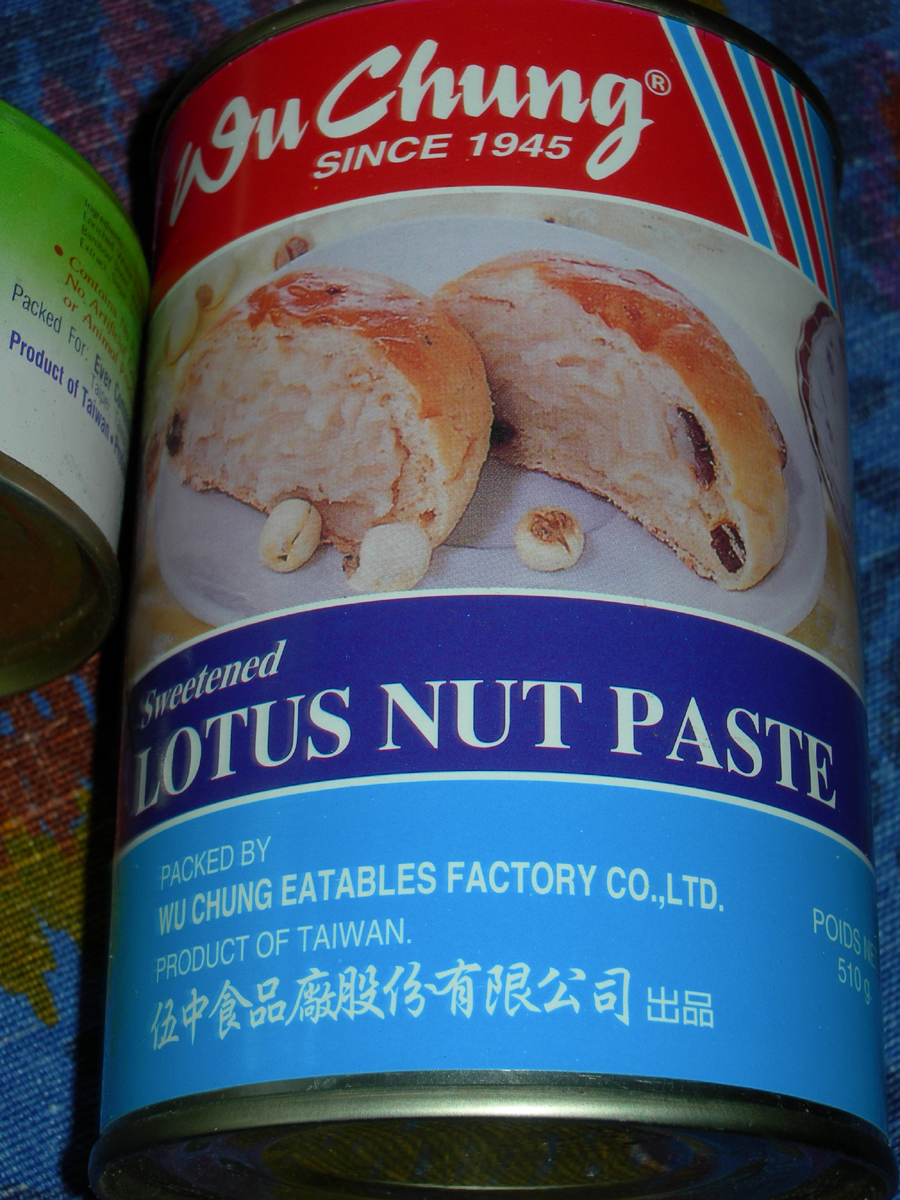 LOTUS STARCH is also known as lotus flour; it is ou fen in Chinese. This flour or starch can be made from lotus seeds or from the swollen rhizome, or it can be made from a mixture of the two. The best, we are told, is produced and extracted in the Jiangsu and the Zhejiang provinces. The Chinese love to use this flour/starch as an instant cereal. They mix it with sugar or honey and tepid water. Then they add boiling water just before serving. Most often it is used by itself, but some manufacturers mix it with water chestnut flour. It can be found canned, and then can be called lotus paste. In this state pne of its uses is as stuffing for dim sum items.
LOTUS STARCH is also known as lotus flour; it is ou fen in Chinese. This flour or starch can be made from lotus seeds or from the swollen rhizome, or it can be made from a mixture of the two. The best, we are told, is produced and extracted in the Jiangsu and the Zhejiang provinces. The Chinese love to use this flour/starch as an instant cereal. They mix it with sugar or honey and tepid water. Then they add boiling water just before serving. Most often it is used by itself, but some manufacturers mix it with water chestnut flour. It can be found canned, and then can be called lotus paste. In this state pne of its uses is as stuffing for dim sum items.
| Chicken with Lotus Flowers |
|---|
1 large chicken breast, cut into matchstick size-size pieces 6 black mushrooms, soaked, stems removed, and cut into matchstick-size pieces 2 ounces Yunnan or Smithfield ham, cut into matchstick-size pieces 1/2 cup canned bamboo shoots, cut into matchstick-size pieces 1 Tablespoon Chinese rice wine 1 teaspoon cornstarch 1 egg white 1 Tablespoon vegetable oil 1 onion, minced 1 slice fresh ginger, minced 1 Tablespoon sesame oil 1 Tablespoon melted chicken fat 2 lotus flowers, petals separated, cut in half, and blanched for fifteen seconds 10 'Melting Mouth' peas, cut into matchstick-size pieces Preparation: 1. In a large bowl, put in the match strip pieces of chicken, mushrooms, ham, bamboo shoots, rice wine, cornstarch, and the egg white. Stir well and let rest for twenty minutes. 2. Heat vegetable oil, stir-fry onions and ginger for one minute or until soft and turning brown. Then, add sesame oil and the entire chicken mixture and stir-fry another minute. 3. Add chicken fat, lotus flowers, and pea strips and stir-fry one minute, then serve. |
| Lotus Chips |
|---|
3 sections fresh lotus stems 2 Tablespoons cornstarch 2 cups vegetable oil 1/4 teaspoon salt Preparation: 1. Peel lotus stems, cut away their ends, them cut them crosswise on an angle into one-sixteenth-inch slices. Toss them with the cornstarch and set aside for half an hour. Shake the slices in a colander to remove any excess cornstarch. 2. Heat oil and deep fry half the slices until golden brown. Remove, drain on paper towels. Fry the second half of them, and drain as before. Then put fried slices or chips into a bowl and sprinkle salt over them, stir, and serve or use as decor. |
| Rice-stuffed Lotus Stems |
|---|
3 sections fresh lotus stems, ends removed and peeled 1/4 cup glutinous rice, soaked in one cup of water overnight 2 Tablespoons sugar 1 teaspoon rose water (optional) 1/2 cup cooked (for forty-five minutes) or canned lotus seeds Preparation: 1. Rinse lotus stems, then mix drained rice and the sugar, and stuff this into all the holes. Gently push the rice in with a chop stick, but do not pack it too tightly. 2. Steam the stuffed lotus stems over simmering water for ninety minutes, remove, and cool. 3. Mix prepared or canned lotus seeds with the rose water and let sit for half an hour. 4. Dice lotus stems into one-quarter-inch pieces, and put them into a bowl. Add lotus seeds and rose water, stir once or twice, and serve. |
| Stir-fried Pork with Lotus Two Ways |
|---|
2 young lotus leaves, blanched and cut into thin three-inch long shreds 2 Tablespoons chicken stock 1/2 pound pork loin, thin-sliced 1 Tablespoon lotus stem or lotus seed flour 1 Tablespoon vegetable oil 1 slice fresh ginger, minced 1 clove garlic, peeled and minced 1 Tablespoon Chinese rice wine 1 Tablespoon thin soy sauce 2 sections lotus stems, peeled and sliced thin or cut into half-inch dice 1 cup mushroom stock 1 Tablespoon dark soy sauce 1 ounce Yunnan or Smithfield ham, minced 2 scallions, cut into half-inch pieces Preparation: 1. Steam lotus leaves in chicken stock for one minute, drain and spread these around the edges of a serving plate. 2. Mix pork pieces with lotus flour, and let rest for fifteen minutes. 3. Heat wok or a pan, then add the oil and stir-fry ginger and garlic for half minute, then add pork pieces and stir-fry another minute before adding rice wine, thin soy sauce and the lotus stem pieces. Stir once or twice, then add ham pieces and the mushroom liquid. Cover and simmer for five minutes or until the lotus pieces are tender. 4. Put in the center of the platter, sprinkle scallion pieces on top, and serve. |
| Lotus Leaf Congee |
|---|
2 cups glutinous rice, soaked overnight, then drained 5 young lotus leaves 25 canned or lotus seeds simmered for half an hour 1/4 cup sugar Preparation: 1. Put rice, lotus leaves, and lotus seeds in four quarts of water. Bring to the boil, reduce heat, then simmer uncovered for one hour. 2. Remove the leaves and simmer for another half an hour before adding the sugar. Stir well, and serve hot or warm. |
| Wrapped Congee |
|---|
2 cups glutinous rice, soaked overnight in four cups water 4 tender fresh lotus leaves 30 lotus seeds, pre-cooked or canned 3 Tablespoons sugar thin string cut into sixteen ten-inch strips Preparation: 1. Put rice, lotus leaves, and lotus seeds in a large pot. Cover them with water, bring to a boil, and simmer uncovered for one hour. 2. Remove leaves and set them aside to cool. 3. Drain rice and lotus seeds, stir, then mash them just a little. 4. Put two stings one each going across the rice bowl in two directions. Then, cut lotus leaves into quarters, and take two to line each of eight rice bowls. 5. Put one-eighth of the rice-lotus seed mixture into each bowl, close the leaves over the rice mixture, and using the stings tie them closing the rice mixture within. Place them on a serving platter, and serve this summer dish at room temperature. |
| Precious Pudding |
|---|
1 cup glutinous rice, soaked overnight or for at least three hours in two cups of cold water 1 Tablespoon chicken fat, butter, or vegetable oil 2 Tablespoons sugar 1 piece candied papaya or another flat fruit 1/2 cup canned lotus seeds 1/4 cup Chinese dates, raisons or any dried fruit 1 Tablespoon honey 1 pound canned red bean paste 1 teaspoon almond extract Preparation: 1. Steam rice over boiling water for half an hour. 2. Mix it with half the fat, and use the other half to grease a heat-proof bowl. 3. Take a few pieces of the papaya and the lotus seeds and place them in a pattern at the base of the bowl. 4. Mix any left over diced candied papaya with the other dried fruit or raisons with the sugar and the honey and the lotus seeds, then stir into the rice. Put half the rice in the bowl being careful not to dislodge the pattern of the papaya and lotus seeds. Then put the red bean paste evenly over the rice, but do not put any on the outer quarter-inch of rice. Next, put the rest of the rice on this paste over the bean paste; be sure to put it to the edge of rice. 5. Steam rice mixture for half an hour, then remove from the steamer and turn rice mixture over onto a clean serving plate. Serve hot or warm, as desired. |

Copyright © 1994-2025 by ISACC, all rights reserved
Address
3 Jefferson Ferry Drive
S. Setauket NY 11720